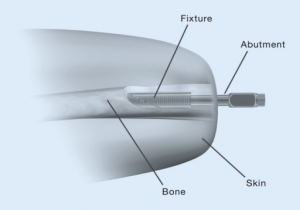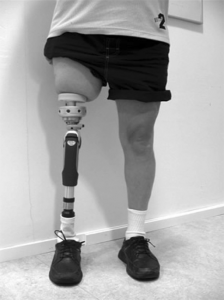Background

Osseointegration (OI) is a procedure that has been used over the last several decades; it was first used in animal models in the 1940s and 50s, and then utilized in dental implants in the 1960s (Rudy, Levi, Bonacci, Weisgold, & Engler-Hamm, 2008; Williams & Isaacson, 2014). More recently, osseointegration has also become an option for attachment of prosthetics in extremity amputation (Mavrogenis, Dimitriou, Parvizi, & Babis, 2009). As the name suggests, this procedure involves the integration of a titanium implant directly into a long bone (e.g. femur, humerus). The bone cells attach and grow around the titanium implant, which allows for incorporation of the implant with normal bone growth. In the instance of amputation, the titanium implant is fit into the residual bone left over after the amputation, and the prosthetic can be directly fitted onto the implant. The direct integration of the implant with the bone provides a secure fixation for the prosthetic for anchorage and the titanium composition of the implant prevents rejection from occurring.
Though osseointegration used for extremity amputation has gained approval and acceptance in several counties, it is still a relatively novel procedure in many areas. Indeed, while nations such as Australia, the United Kingdom, and other European countries have been on the forefront of utilizing osseointegration and have performed many of these operations, other Western countries have been slower to adopt this procedure.

As numbers worldwide are still relatively small and persons who have undergone OI are spread out, a number of groups have formed, using social media platforms, to share experiences between individuals who have undergone this procedure or are deciding to have it done. One group in particular, which has over 3000 members, is the Facebook group entitled the Osseointegration Peer Support Group. The posts by members of this group reflect a broad range of individual experiences both with the surgery and the ensuing recovery period. While there are many positive outcomes of OI that are shared on this Facebook site, it is also used by people who have had OI to “check-in” and compare their symptoms and the progress of their healing with others, and to get a sense of what is part of the normal recovery process and what isn’t and should be seen by a health care provider. There is a lot of information on the site and it can be quite overwhelming to search the many years of posts to find out what others have experienced and what they have done in response. To make it easier for people who have recently undergone OI we have searched and compiled some of the main concerns that have been discussed by members of the Osseointegration Peer Support Group on Facebook.
Although every experience observed by each individual who has undergone osseointegration is unique, there were concerns that were repeated more frequently and these are what was focused on in this booklet. While we suspect these concerns reflect the pattern of typical ‘journeys’ of persons who have had OI, it is important to remember that this information comes solely from those persons who are members of this support group, can communicate in English, and who chose to post their symptoms on this site. They may not be representative of all persons who have undergone OI.
Secondly, it is important to note that the information contained in this booklet in no way constitutes medical advice, and as such, should not be used to diagnose or treat individual complications. This information is a compilation of self-reported outcomes from a variety of symptoms and is to be used for informational purposes only. It should be noted as well that if complications are experienced that require follow-up, it is advised that any questions or concerns be directed to a health care professional.
Finally, some of the pages in this booklet contain images of OI stomas that some readers may find graphic. These images are included to provide a visual example of what is being discussed in that section of the booklet.
